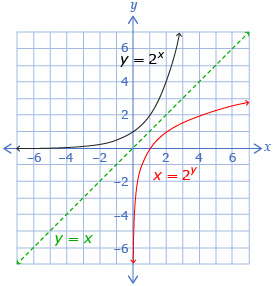Explore
Your graphs, from Try This 1, of y = 2x and its inverse, x = 2y, may have looked similar to the graphs shown here. The inverse is a function because there is only one x-value for each y-value.

A logarithmic function is the inverse of an exponential function. This means that a logarithmic function is a reflection of the corresponding exponential function in the line y = x.
If you take the inverse function, x = 2y, and let x = 8, the function becomes 8 = 2y. This equation can be described in words as “2 to what exponent equals 8?” Instead of writing it this way, a logarithm could be used to describe the exponent. A logarithm is really the exponent that is required to write a value as a power with a specific base.
When you took the inverse of y = 2x, you produced the function x = 2y. If you were to try to isolate the y-value of x = 2y, you would likely get stuck. Logarithms can help isolate y.

In Lesson 1 you learned that an exponential function is a function in the form y = cx, where c > 0, c ≠ 1. The inverse of the exponential function y = cx would be the logarithmic function in the form y = logc x, where c > 0, c ≠ 1. Logc x is pronounced as “log base c of x”; and log2 x is pronounced as “log base 2 of x.”
In Try This 1 you may have stated the following characteristics about the inverse of the exponential function, the logarithmic function:
- The domain is {x|x > 0, x ∈ R}.
- The range is {y|y ∈ R}.
- The x-intercept is 1.
- There is no y-intercept.
- There is a vertical asymptote at x = 0 (the y-axis).
In the next lesson you will take a closer look at the graphs of logarithmic functions. The rest of this lesson will focus on solving logarithmic expressions.
You have seen how useful the logarithmic form can be to help isolate y in an inverse exponential function. In Try This 2 you will learn more about the logarithmic form and look for patterns between exponential form and logarithmic form.